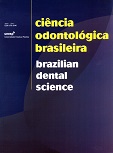Avaliação da forma de preparos cavitários realizados com laser, abrasão a ar e ponta diamantada
DOI:
https://doi.org/10.14295/bds.2005.v8i3.427Abstract
O objetivo deste trabalho foi avaliar a forma do preparo cavitário realizado com ponta diamantada, sistema de abrasão a ar e laser Er:Yag em dentes decíduos. Foram preparadas 23 cavidades em forma de canaletas nas faces vestibular ou lingual que foram divididas em três grupos de acordo com a técnica do preparo. Grupo I: alta rotação + ponta diaman-tada; Grupo II: sistema de abrasão a ar (80 psi, ponta ativa de 80o com distância de 2mm, pó de óxido de alumínio com granulação de 27μm e tempo de aplicação de 15 segundos) e Grupo III: laser Er;YAG (250mJ, 3Hz, tempo de aplicação de 20 segundos e distância focal de 12mm). Posteriormente foram restaurados com resina Filtek Flow (3M) utilizando o adesivo Single Bond (3M) e cortados ao meio com um disco de diamante para serem avaliados em microscopia eletrônica de varredura. Sobre as micrografias obtidas foi colocado um papel de traçado cefalométrico para marcar pontos e linhas correspondentes aos limites das cavidades. Os traçados obtidos foram posicionados em mesa digitalizadora e os pontos digitados com auxílio do programa DFPlus, versão 6.5, 1995, que determinou as medidas de largura, profundidade e os ângulos oclusal, cervical e de abertura das cavidades. Os resultados demonstraram que as cavidades preparadas com ponta diamantada, sistema de abrasão a ar e laser Er: YAG apresentaram largura semelhantes e profundidade, ângulo oclusal , ângulo cervical e ângulo de abertura diferentes.Downloads
Downloads
Published
How to Cite
Issue
Section
License
Brazilian Dental Science uses the Creative Commons (CC-BY 4.0) license, thus preserving the integrity of articles in an open access environment. The journal allows the author to retain publishing rights without restrictions.
=================




























